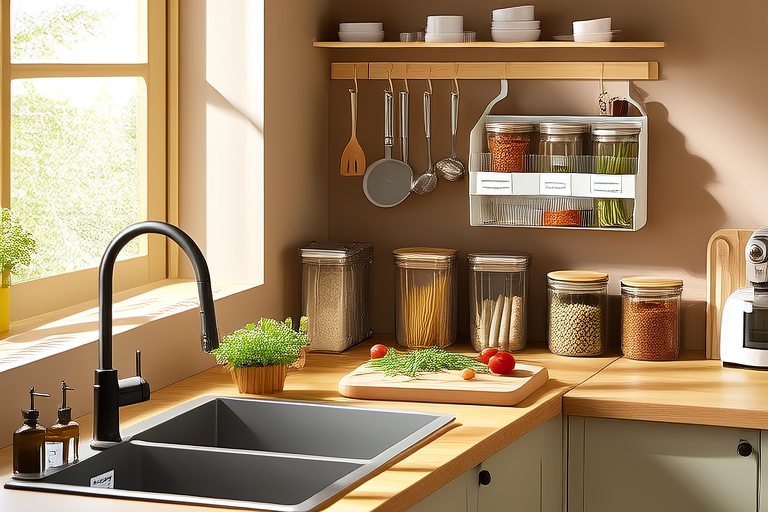Essential Tools and Hacks for Achieving Ultimate Kitchen Organization
Introduction: Why Kitchen Organization Matters
A well-organized kitchen is not just about aesthetics; it’s about efficiency, safety, and convenience. A cluttered kitchen can lead to wasted time searching for ingredients or tools, while an organized one allows you to cook with ease and joy. Whether you’re a seasoned chef or a beginner, having a tidy kitchen can significantly enhance your cooking experience. In this article, we’ll explore essential tools and hacks that will help you achieve ultimate kitchen organization.
Section 1: The Importance of Proper Storage Solutions
1.1. Cabinets and Drawers
Cabinets and drawers are the backbone of any kitchen organization system. Start by decluttering your cabinets and drawers. Remove items you no longer use, and donate or throw away anything that’s expired or broken. Once you’ve cleared out the space, consider investing in drawer dividers and shelf organizers. These tools can help you maximize vertical space and keep everything in its place.
Drawer Dividers
Drawer dividers are particularly useful for utensils and small tools. They prevent items from becoming tangled and make it easier to find what you need quickly. For example, you can organize your silverware drawer with individual slots for each type of utensil, ensuring that every piece has its designated spot.
Shelf Organizers
Shelf organizers come in various shapes and sizes, from simple trays to adjustable dividers. They are ideal for storing spices, condiments, and baking supplies. By grouping similar items together, you can reduce clutter and make your shelves look more organized. Consider using clear bins or jars for smaller items like spices, as they allow you to see what’s inside without opening them.
1.2. Pantry Management
Your pantry is another crucial area for organization. To keep your pantry clutter-free, start by categorizing your food items into groups such as grains, snacks, canned goods, and spices. Use pantry bins or labeling systems to clearly identify each category. This makes it easier to find what you need and helps you avoid overbuying duplicate items.
Pantry Bins
Pantry bins are perfect for storing bulk items like rice, pasta, and flour. They keep these items fresh and prevent spills. You can also use clear bins to store snacks and other dry goods, making it easy to see what you have on hand.
Labeling Systems
Labeling your pantry shelves can be incredibly helpful, especially if you have multiple people using the kitchen. Labels can be as simple as a piece of tape with the item name written on it or as elaborate as custom-designed labels. Consider using magnetic labels for items stored on metal shelves or chalkboard labels for a more personalized touch.
Section 2: Efficient Cooking and Prep Space
2.1. Countertop Organization
The countertop is often the most used surface in the kitchen, so keeping it organized is key. Start by designating specific areas for frequently used items like cutting boards, knives, and mixing bowls. Consider using under-the-sink storage or wall-mounted racks to free up counter space.
Under-the-Sink Storage
Under-the-sink storage units are perfect for hiding bulky items like garbage bags, cleaning supplies, and extra containers. They keep these items out of sight and off the countertops, giving you more room to work.
Wall-Mounted Racks
Wall-mounted racks can be used to hang pots, pans, and utensils, freeing up valuable counter space. They also add a decorative element to your kitchen, making it feel more organized and stylish.
2.2. Prep Zones
Creating dedicated prep zones can streamline your cooking process and reduce clutter. A prep zone should include all the tools and ingredients you need for a particular task. For example, you might set up a cutting station with a cutting board, knives, and a bowl for scraps. Similarly, you can create a mixing station with a bowl, spoon, and measuring cups.
By organizing your prep zones, you can minimize the number of trips you need to make around the kitchen, saving both time and energy. Additionally, having everything within reach reduces the likelihood of creating unnecessary messes.
Section 3: Cleaning and Maintenance Tips
3.1. Regular Cleaning Routines
Maintaining an organized kitchen requires regular cleaning. Establish a routine that includes daily, weekly, and monthly tasks. Daily tasks might include wiping down surfaces and putting away dishes, while weekly tasks could involve deep-cleaning appliances and sanitizing sponges. Monthly tasks might include decluttering cabinets and checking expiration dates on pantry items.
3.2. Proper Disposal and Recycling
Proper disposal and recycling are essential for maintaining a clean and organized kitchen. Make sure you have clearly labeled trash and recycling bins in convenient locations. Encourage family members or housemates to participate in the recycling process by educating them on what can and cannot be recycled.
Practical Case Study: Organizing a Small Kitchen
Let’s take a look at how you can apply these tips to a small kitchen. In a small kitchen, space is limited, so it’s important to use every inch wisely.
Step-by-Step Guide:
- Declutter: Begin by removing all non-essential items from your kitchen. Donate or throw away anything that’s expired or broken.
- Invest in Multi-Purpose Tools: Choose tools that serve multiple purposes. For example, a versatile knife set can replace several single-purpose knives, saving space.
- Use Vertical Space: Install wall-mounted racks and shelf organizers to maximize vertical space. This will free up valuable counter and cabinet space.
- Implement a Cleaning Schedule: Establish a regular cleaning schedule to maintain the organization. This will prevent clutter from building up over time.
Conclusion: Take Action Today
In conclusion, achieving ultimate kitchen organization is within reach with the right tools and strategies. By focusing on proper storage solutions, efficient cooking and prep spaces, and regular maintenance, you can create a kitchen that is both functional and beautiful. Start by implementing some of the tips discussed in this article, and gradually build upon your organization system. Remember, the key to a well-organized kitchen is consistency and attention to detail. Happy organizing!
